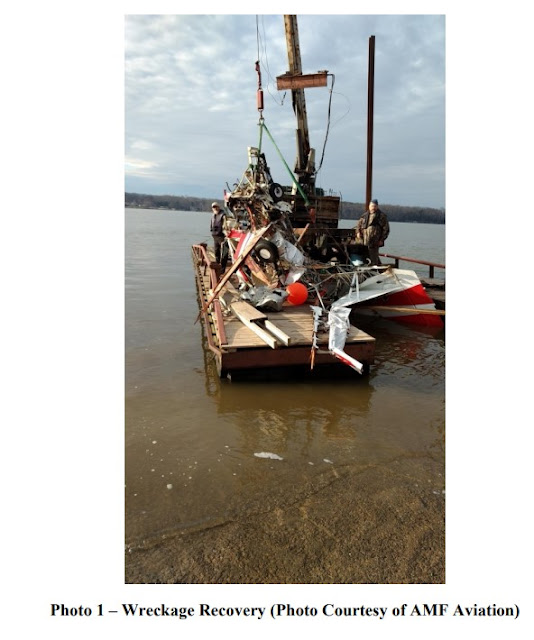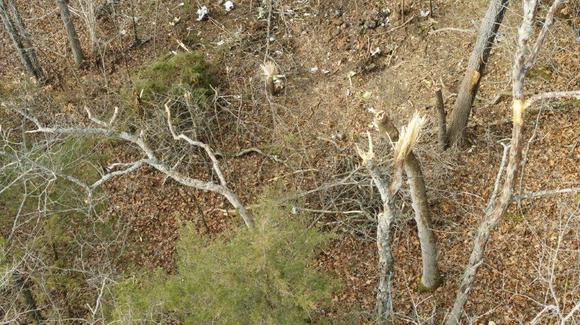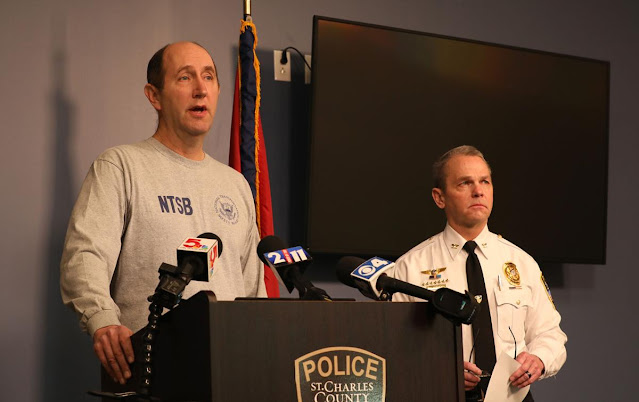Investigation Docket - National Transportation Safety Board:
Location: Soddy-Daisy, Tennessee
Accident Number: ERA19LA080
Date and Time: January 7, 2019, 13:34 Local
Registration: N8849V
Aircraft: Bellanca 1730
Aircraft Damage: Destroyed
Defining Event: Loss of control in flight
Injuries: 2 Fatal
Flight Conducted Under: Part 91: General aviation - Personal
Analysis
A witness saw the airplane fly over a lake and noted that the airplane made "a tight U-turn" at a low altitude, which he thought might have been an aerobatic maneuver. The airplane then spiraled straight down counterclockwise and impacted the lake. Video from a camera mounted to the airplane's right horizontal stabilizer confirmed that the airplane flew very low over water. Subsequent video showed that the airplane pitched up, rolled to the left, and entered a left spin before descending and impacting the lake. It is likely that the pilot had attempted a left wingover maneuver (in which the airplane makes a steep climb followed by a vertical turn and subsequent descent), but the airplane experienced an aerodynamic stall that led to the left spin near the top of the maneuver. The video revealed no evidence of a preimpact structural failure, flight control malfunction, or loss of propeller rpm. Additionally, postaccident examination of the airframe and engine revealed no preimpact mechanical malfunctions that would have precluded normal operation.
The pilot's toxicology results indicated that he had previously taken some cough and cold medications, including some that were potentially sedating. However, these medications were out of his system, as shown by the absence or low levels of these medications in the pilot's blood. Thus, the pilot's use of these medications was not likely a factor in this accident.
Probable Cause and Findings
The National Transportation Safety Board determines the probable cause(s) of this accident to be:
The pilot's improper decision to attempt an aerobatic maneuver at low altitude, which led to an aerodynamic stall and spin from which the pilot could not recover.
Findings
Personnel issues Decision making/judgment - Pilot
Aircraft Angle of attack - Not attained/maintained
Factual Information
History of Flight
Maneuvering-aerobatics Loss of control in flight (Defining event)
Maneuvering-aerobatics Aerodynamic stall/spin
Uncontrolled descent Collision with terr/obj (non-CFIT)
On January 7, 2019, about 1334 eastern standard time, a Bellanca 17-30A, N8849V, was substantially damaged when it impacted Lake Chickamauga, while maneuvering near Soddy-Daisy, Tennessee. The commercial pilot and the passenger were fatally injured. The airplane was owned by the pilot who was operating it as a Title 14 Code of Federal Regulations Part 91 personal flight. Visual meteorological conditions prevailed at the time of the accident, and no flight plan was filed for the local flight, which originated from Dallas Bay Sky Park, Chattanooga, Tennessee, about 1328.
A witness stated that he was at his residence watching the accident airplane fly over the lake. He noted that the airplane appeared to make "a tight U-turn" at a low altitude, about two or three treetop lengths above the water, which he thought might have been an aerobatic maneuver. The airplane then spiraled straight down counterclockwise and impacted the lake. The witness contacted emergency services and assisted local responders in finding the wreckage.
A GoPro camera was mounted on both the left and right horizontal stabilizers. The cameras were forwarded to the National Transportation Safety Board's Vehicle Recorders Division, Washington, DC, for examination.
Review of the video files revealed that only the camera mounted on the right horizontal stabilizer captured the accident sequence. The video files from that camera revealed that the airplane took off about 13 minutes after the recording began. About 5 minutes later, the airplane flew over a body of water and descended closer to the water for about 1 minute and then remained level for 22 seconds. The airplane subsequently pitched up more than 30° above the horizon and began rolling to the left. The airplane continued to roll to the left and entered a left spin. During the spin, the right aileron and the flaps were in an up position. The airplane then departed controlled flight and impacted the water.
Review of the video showed no in-flight structural failure or loss of propeller rpm.
Pilot Information
Certificate: Commercial
Age: 67, Male
Airplane Rating(s): Single-engine land; Multi-engine land
Seat Occupied: Left
Other Aircraft Rating(s): Helicopter
Restraint Used: 4-point
Instrument Rating(s): Airplane; Helicopter
Second Pilot Present: No
Instructor Rating(s): None
Toxicology Performed: Yes
Medical Certification: Class 2 With waivers/limitations
Last FAA Medical Exam: February 1, 2018
Occupational Pilot: Yes
Last Flight Review or Equivalent: October 9, 2018
Flight Time: 3800 hours (Total, all aircraft), 357 hours (Total, this make and model)
The pilot held a commercial pilot certificate with ratings for airplane single-engine land, airplane multiengine land, helicopter, instrument airplane, and instrument helicopter. His most recent Federal Aviation Administration (FAA) second-class medical certificate was issued on February 1, 2018. At that time, the pilot reported a total flight experience of 3,800 hours.
According to an FAA inspector, the pilot's hard-copy logbook ended in 1985, and an electronic log for the airplane began in 2013. Information about the pilot's flight time between those dates was not available. According to the electronic log, the pilot had accumulated 357 hours of flight experience in the accident airplane make and model, of which 17 hours were flown during the 90 days preceding the accident.
Aircraft and Owner/Operator Information
Aircraft Make: Bellanca
Registration: N8849V
Model/Series: 1730 A
Aircraft Category: Airplane
Year of Manufacture: 1971
Amateur Built:
Airworthiness Certificate: Normal
Serial Number: 30376
Landing Gear Type: Tricycle
Seats: 4
Date/Type of Last Inspection: June 1, 2018 Annual
Certified Max Gross Wt.: 3325 lbs
Time Since Last Inspection: 34 Hrs
Engines: 1 Reciprocating
Airframe Total Time: 2156 Hrs as of last inspection
Engine Manufacturer: Continental
ELT: Installed, not activated
Engine Model/Series: IO-520-K
Registered Owner:
Rated Power: 300 Horsepower
Operator: On file
Operating Certificate(s) Held: None
The four-seat, low-wing, fixed-tricycle landing gear airplane was manufactured in 1971. It was powered by a 300-horsepower Continental IO-520 engine equipped with a constant-speed propeller. Review of the maintenance records revealed that the airplane's most recent annual inspection was completed on June 1, 2018. At that time, the airframe and engine had accrued 2,156 total hours since new.
Meteorological Information and Flight Plan
Conditions at Accident Site: Visual (VMC)
Condition of Light: Day
Observation Facility, Elevation: CHA, 682 ft msl
Distance from Accident Site: 19 Nautical Miles
Observation Time: 13:53 Local
Direction from Accident Site: 200°
Lowest Cloud Condition: Few / 15000 ft AGL
Visibility 10 miles
Lowest Ceiling: Broken / 30000 ft AGL
Visibility (RVR):
Wind Speed/Gusts: 12 knots / 21 knots
Turbulence Type Forecast/Actual: None / None
Wind Direction: 170°
Turbulence Severity Forecast/Actual: N/A / N/A
Altimeter Setting: 30.12 inches Hg
Temperature/Dew Point: 19°C / 4°C
Precipitation and Obscuration: No Obscuration; No Precipitation
Departure Point: Chattanooga, TN (1A0)
Type of Flight Plan Filed: None
Destination: Chattanooga, TN (1A0)
Type of Clearance: None
Departure Time: 13:28 Local
Type of Airspace:
The recorded weather at 1353 at Lovell Field (CHA), Chattanooga, Tennessee, which was located about 19 miles southwest of the accident site, was wind from 170° at 12 knots gusting to 21 knots, visibility 10 miles, few clouds at 15,000 ft, few clouds at 20,000 ft, broken ceiling at 30,000 ft, temperature 19°C, dew point 4°C, and altimeter setting 30.12 inches of mercury.
Wreckage and Impact Information
Crew Injuries: 1 Fatal
Aircraft Damage: Destroyed
Passenger Injuries:
1 Fatal Aircraft Fire: None
Ground Injuries: N/A
Aircraft Explosion: None
Total Injuries: 2 Fatal
Latitude, Longitude: 35.328609,-85.055557
The airframe was recovered from the lake; the empennage had been cut by recovery personnel for transport. An FAA inspector examined the airframe and noted that the cockpit and cabin area were crushed and that both wings were highly fragmented. The inspector confirmed control continuity from the elevator and rudder to the cockpit area. He also noted aileron cables extending from the cockpit area to their respective wing. The front seat four-point harnesses remained intact.
The engine was recovered about 5 months after the airframe. The crankshaft fracture surfaces exhibited jagged shear lips, and the exposed steel was covered with rust. The engine was examined by the engine manufacturer under the supervision of an FAA inspector. The engine's crankshaft was manually rotated via an accessory drive gear, and all six cylinders produced thumb compression. Corrosion was present on cylinder cooling fins and fuel system components. The rocker cover on cylinder No. 6 was broken and partially separated, exposing the exhaust valve stem and valve spring assembly. The rocker arm for the cylinder No. 6 exhaust valve had separated. All other rocker covers remained intact. An electronic borescope inspection was performed; all intake and exhaust valves were intact, and the valve faces exhibited normal combustion deposits. The propeller was not recovered.
Examination of the airframe and engine revealed no preimpact mechanical malfunctions that would have precluded normal operation.
Medical and Pathological Information
The Hamilton County, Tennessee, Medical Examiner performed an autopsy of the pilot. The autopsy results found that the pilot's cause of death was multiple blunt force injuries.
Toxicology testing was performed at the FAA Forensic Sciences Laboratory and detected dextromethorphan, a nonsedating cough suppressant, and its metabolite dextrorphan in the pilot's urine specimens but not in his cavity blood. Both chlorpheniramine and doxylamine, sedating antihistamines used for treating cold or hay fever symptoms, were also detected in the pilot's urine specimens; there were inconclusive detection results for these medications in the pilot's cavity blood. In addition, ibuprofen, a nonsteroidal anti-inflammatory pain medication, was detected in the pilot's urine specimens.



































































